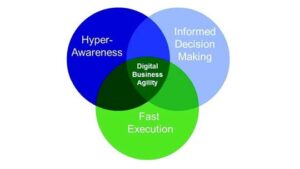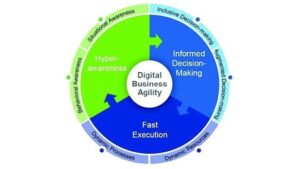In May 2016, around 80 executives from 42 global organizations attended an IMD Discovery Event hosted by the Global Center for Digital Business Transformation. The aim of the event was to explore how Digital Business Agility (the cornerstone of competitiveness in the Digital Vortex) applies to the workforce.
The Global Center for Digital Business Transformation (DBT Center) introduced the construct of Digital Vortex to conceptualize the way digital disruption affects firms and industries. It was based on a survey of close to 1,000 executives in 12 industries around the world (refer to insights@IMD No. 59: Strategies for Responding to Digital Disruption for more details on the Digital Vortex). The Digital Vortex implies an inevitable move toward a digital center in which business models, offerings and value chains are almost fully digitized. No industry is immune to disruption.
In response, incumbents are beginning to develop agility, a critical capability that is often lacking. Unfortunately, however, many companies focus their transformation efforts on IT and business processes alone, often neglecting people. In fact, a great way for incumbents to fight against digital disruptors and to generate new value for customers is to focus on managing their workforce better. This Discovery Event explored ways of empowering people and transforming the workforce to drive new levels of collaboration, innovation and ultimately the success of the whole company.
What is agility in the digital age?
The three things that a company needs in order to be agile are hyperawareness, informed decision making, and fast execution (see Figure 1); what the DBT Center refers to as “Digital Business Agility” (DBA). Companies need to develop these capabilities to respond quickly and effectively to emerging threats to their businesses, and to seize new market opportunities. Moreover, while these capabilities can be understood as discrete, they actually form a complex, interacting foundation for the whole enterprise.
Hyperawareness is a company’s ability to detect and monitor changes in its business environment. Companies that are hyperaware are attuned to what is going on around them, particularly to changes that highlight opportunities or threats. Such insights can be captured not only internally from employees, for example, or the organization’s internal operating environment, but they can also be obtained from external sources, such as customers, partners and competitors.
Companies like Nestlé are good at gaining insights from customers. Following a huge social media attack on one of its key brands, Nestlé created the Digital Acceleration Team (DAT) to monitor social media. DAT, a leadership training program for digital marketing projects, is a social listening place where Nestlé can find out what consumers are talking about and communicate with them in the right context, enabling them to become ambassadors for Nestlé.
Informed decision making is a company’s ability to make the best possible decision in a given situation. To do this, active decisions must be based on real data, rather than past experiences and shared throughout the organization. To excel in informed decision making, companies must develop mature data analytics capabilities that augment human judgment.
However, despite having the information they need to make the right moves, many companies fail. Often, this is because assumptions held by top management were not tested or questioned. Decisions based purely upon “gut feeling” or past experience have little chance of success.
Fast execution is a company’s ability to carry out its plans quickly and effectively, enabling it to put decisions into practice rapidly, mobilize people and resources dynamically, and continuously monitor options and progress against goals. Unfortunately, large incumbents are often slow to execute due to organizational complexity and reluctance to make changes.
The ability to learn and adapt is the most important for companies to facilitate innovation. Some are not willing to launch innovative new products and services because they think that the potential cost of failure in the digital context is too high. However, a company fails only if it does not learn something from a negative experience. Experimentation and tolerance of failure are important ways of collecting invaluable feedback and are thus essential to success in the Digital Vortex.
DBAs in workforce management
Workforce management is a critical element of any digital transformation effort. DBT Center research has identified six specific “digital accelerators” that apply to workforce management and support the capabilities of digital business agility (see Figure2). Two digital accelerators correspond to each of the three capabilities. These combine people, business process changes and technology to give voice to employee insights, apply analytics to the point of decision, and identify and allocate talent to execute the decisions as efficiently as possible. By implementing them, companies can take meaningful strides toward transforming their workforces to compete successfully in the Digital Vortex.
Hyperawareness for workforce transformation
The two digital accelerators that relate to hyperawareness in the workforce are “behavioral awareness” and “situational awareness.” Their function is to harvest data about the internal and external business environment from the workforce, customers and the operational environment. This includes, for example, gleaning insights about what customers value from frontline sales associates, monitoring manufacturing facilities, or capturing frank assessments of corporate strategy from the people who see their effects on a daily basis.
To enable “behavioral awareness,” effectively collecting data from a workforce consisting of thousands (even tens of thousands) of employees and contractors, companies need technological assistance. For example, apps such as Waggl provide an easy way for employees to give anonymous feedback in real time. This fosters a “listening culture” that can help to bring “valuable” negative feedback to the surface.
Other tools can help to uncover hidden patterns of work, revealing exactly how organizations operate, and enabling beneficial changes to be made. A company’s employee productivity and organizational simplicity can be hugely improved simply by analyzing its communications data.
“Situational awareness” means sensing changes in the marketplace – including the company’s customer base, competitors and partner ecosystem – that are relevant to an organization’s mission. It also includes sensing the operating environment – monitoring changes in physical assets such as oil rigs, manufacturing plants, vehicle fleets and facilities that companies use to deliver the products or services they sell.
An example of complete situational awareness and control is Dundee Precious Metals, which uses data analytics to save lives. It operates mines in harsh environments with multiple hazards to humans and physical assets. By connecting the entire mine environment, including personnel, conveyors, haulers, lights and blasting equipment to one connected “smart mine system,” it not only improved worker safety but also quadrupled production.
Informed decision making for workforce transformation
Informed decision making in workforce transformation entails not only improving big, strategic decisions that shape a company’s future but also the millions of smaller decisions that employees make every day. The “augmented decision making” digital accelerator incorporates “ubiquitous analytics,” which embeds analytics and informed decisions directly into the work process, providing both executives and employees with the tools to make the best decisions in a given context. It also includes “automated or fast decisions,” whereby technology helps accelerate the speed of decision cycles through automation and analytics.
Proctor & Gamble, for example, use “business spheres” and “decision cockpits” to augment decision making. These are connected meeting spaces equipped with intuitive data visualization walls enabling the use of real-time data during the decision-making process. The outcome provides more than 50,000 employees with real-time actionable data and insights through desktop dashboards.
Informed decision making is also about ensuring that decisions are influenced by employees with the right expertise, diversity of background and cognitive perspectives. Companies that excel at bringing experts and diverse perspectives into the decision-making process are more successful innovators. The “inclusive decision making” digital accelerator taps into and connects the shared intelligence of the workforce while giving voice to diverse viewpoints and expertise.
New tools enable high-speed, data-driven decision making in a group environment using proprietary algorithms – driving collective decision making through multi-criteria voting. Research so far indicates a potential 70% saving in decision-making process time.
Informed decision making also includes state-of-the-art augmented reality applications that support employees at the point of operation. Giant logistics firm DHL has been experimenting with head-mounted displays using augmented reality glasses to provide real-time task information on the picking process in its warehouses. This customized support for front-line staff helps employees to plan their own activity more efficiently with the outcome indicating a 25% productivity increase from a pilot group.
Fast execution for workforce transformation
The workforce plays a huge role in ensuring that a company executes with speed and excellence. Fast execution for workforce transformation hinges on two fronts: resources and processes.
Dynamic resources are a company’s human, financial and technological capital – acquired, deployed, managed and shifted rapidly, as business conditions dictate. They can be divided into two types of resources: 1) agile talent – the ability to find workers with the necessary skills and knowledge and to assemble teams with speed and precision; and 2) agile technology – the ability to obtain technology resources quickly and to use technology infrastructure to meet emerging business needs.
An important part of allocating talent is ensuring that employees are engaged in valuable and interesting work. Underutilizing valuable employees has two major downsides: less value from them, and the probability that they will quit. Software solutions, such as Workday, can leverage internal HR data and external data sources to identify employees at risk of attrition.
Dynamic processes are the structured activities by which organizational goals are accomplished. They are also made up of two components: 1) rapid intervention – the ability to adjust day-to-day operations and capture value that is time-bound; and 2) rapid enablement – the ability to create new organizational capabilities quickly across a broad spectrum of activities including marketing, customer support, commerce and application development.
Optimal staffing is extremely hard to achieve, but aligning staffing levels with changing traffic patterns avoids lost sales and improves profitability. Software company Percolata uses dynamic processes to provide optimal staffing. Retail store sensors capture video and audio from real-time traffic, and the location of shoppers from their smartphones. This is integrated with the store’s point-of-sale data. Percolata uses this to forecast future store traffic which automatically generates schedules for retail associates using machine-learning technology. The system also adapts schedules to changes in store traffic, helping stores to quickly allocate their staff. This is fast execution.
Economic Value
Ultimately, transformative efforts are targeted at creating value – economic value for the organization and value for the customer through cost, experience and platform. It not surprising to find that people are the key to this – in fact, research indicates this is becoming even more pronounced with 64% of digital value coming from people-centric applications – a rise of 9% since it was first tested in a 2013 analysis.
This can be measured by looking at what powers the digital world: machine-to-machine (M2M), person- to-machine (P2M) and person-to-person (P2P). In previous analysis, people-centric connections (P2P, P2M) drove 55% of the estimated “value at stake” for the private sector. Now, the contribution of people- centric connections to private sector “digital value at stake” has grown by 9 percentage points – to 64%. This increase reflects the greater ability of many organizations to optimally match the “people” and “process” elements of digital business with the “things.”
Given this centrality of people to creating value, it is clearly vital to success in a disrupted business environment to engage, retain and efficiently deploy a high-performing workforce. Re-imagining a business to take best advantage of its most valuable asset, its “workforce transformation,” is at the heart of digital business agility and drives success in the turbulent world of the Digital Vortex.
| Millennials and Building Digital Talent
Employees are human! An obvious statement, but Professor Martha Maznevski’s work strongly emphasizes that it is the people who enable digital business transformation – not systems. Her work makes clear that central to the transformation agenda is the coming generation of “millennials” whose aspirations, ambitions and motivations need to be understood if organizations are to successfully transform. So who are the millennials and what characteristics might they bring to the workforce? Generally speaking the definition is those born between 1982 and 2004 – proposed by William Strauss and Neil Howe in their defining book on the subject, Millennials Rising: The Next Great Generation. The precise boundaries though are less important than the fact that millennials are now the largest single generation in the global workforce. Stereotypically, millennials have been cast as the “me, me, me” generation – denigrated as self-centered, spoiled and lazy. But this of course is not how they see themselves, nor how they should be treated in the workforce. What they bring, almost inevitably, is a familiarity with technology which has been with them since their teenage years. But alongside their growing up with ubiquitous technology, they have seen huge upheavals and global change – as Professor Maznevski puts it: “Millennials are even more familiar with uncertainty than they are with technology.” And this in part has led to a number of defining characteristics that impact their integration into a digital workforce:
There is a strong correlation between these tendencies and the organizational behavior of transformed businesses. Hyperawareness, informed decision making and fast execution fit well with principles such as anticipating uncertainty (which fosters agility), loyalty, diverse decision making and corporate inclusion, plus “fail fast” approaches, which require learning through experience. In fact, millennials come ready for digital business, no transformation is needed! The assumption should be that they are ideally suited to the needs of digital business agility. |
Discovery Events are exclusively available to members of IMD’s Corporate Learning Network. To find out more, go to www.imd.org/cln







